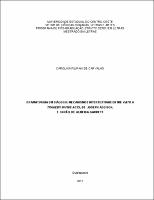| Compartilhamento |


|
Use este identificador para citar ou linkar para este item:
http://tede.unicentro.br:8080/jspui/handle/jspui/894Registro completo de metadados
| Campo DC | Valor | Idioma |
|---|---|---|
| dc.creator | CARVALHO, CAROLINA FILIPAKI DE | - |
| dc.creator.Lattes | http://lattes.cnpq.br/3638443094234490 | por |
| dc.contributor.advisor1 | Silva, Edson Santos | - |
| dc.contributor.advisor1Lattes | http://lattes.cnpq.br/2855415041274093 | por |
| dc.date.accessioned | 2018-11-26T12:45:55Z | - |
| dc.date.issued | 2017-09-20 | - |
| dc.identifier.citation | CARVALHO, CAROLINA FILIPAKI DE. DRAMATURGIA EM DIÁLOGO: MECANISMOS INTERTEXTUAIS ENTRE CATO A TRAGEDY IN FIVE ACTS, DE JOSEPH ADDISON, E CATÃO, DE ALMEIDA GARRETT. 2017. 136 f. Dissertação (Programa de Pós-Graduação em Letras - Mestrado) - Universidade Estadual do Centro-Oeste, Guarapuava - PR. | por |
| dc.identifier.uri | http://tede.unicentro.br:8080/jspui/handle/jspui/894 | - |
| dc.description.resumo | Esta pesquisa propõe a análise das relações intertextuais entre as obras homônimas Catão, publicada por Joseph Addison, em 1713, na Inglaterra, e Almeida Garrett, em 1822, em Portugal. O escritor português admitiu ter se inspirado na obra inglesa para conceber a sua. Diante disso, foram investigados nesta dissertação os fatores que aproximam os dois dramas numa perspectiva intertextual, a qual encontra sua base teórica em Kristeva (1969), Bouché (1974), Genette (1982), Sant’Anna (1985) e Hutcheon (1991), dentre outros estudiosos. O arcabouço teórico traz à baila questões relacionadas à Literatura Comparada, pelo viés abordado por Nitrini (2000) e Carvalhal (2010). A comparação entre os textos revelou que os dois autores eram engajados e que as peças foram escritas com o intuito de promover a alegoria dos momentos políticos vivenciados pelos autores em seus países. Concluiu-se que a peça garrettiana, por travar um diálogo intertextual com a intenção de emular o texto addisoniano, é uma estilização do drama inglês. Além dos mecanismos intertextuais usuais, a exemplo da citação e alusão, cinco mecanismos descritos por Bouché (1974), como característicos da paródia, foram encontrados no texto estilizado e receberam uma nova nomenclatura: acréscimo parafrásico estilizador; translocução estilizadora; supressão estilizadora; translocução supressiva estilizadora e fragmentação supressiva estilizadora. | por |
| dc.description.abstract | This research aims to analyze the intertextual relations between the homonymous literary oeuvre Cato, published by Joseph Addison, in 1713, in England, and Almeida Garrett, in 1822, in Portugal. The Portuguese writer admitted that he was inspired by the English work to conceive his own. Therefore, it was investigated in this dissertation the factors that approximate the two dramas in an intertextual perspective, which is based on the studies of Kristeva (1969), Bouché (1974), Genette (1982), Sant'Anna (1985) and Hutcheon (1991), among other scholars. The theoretical framework raises questions related to Comparative Literature, through the approach addressed by Nitrini (2000) and Carvalhal (2010). The comparison between the texts revealed that the two authors were socially engaged and that the plays were written with the intention to promote the allegory of the political moments experienced by the authors in their own countries. It was concluded that the play written by Garrett, for its intertextual dialogue with the intention of emulating Addison’s play, is a stylization of the English drama. In addition to the usual intertextual mechanisms, like the citation and allusion, five mechanisms described by Bouché (1974), as characteristic of the parody, were found in the stylized text and received a new nomenclature: stylizing paraphrasic addition; stylizing translocution; stylizing suppression; stylizing suppressive translocution and stylizing suppressive fragmentation. | eng |
| dc.description.provenance | Submitted by Fabiano Jucá (fjuca@unicentro.br) on 2018-11-26T12:45:55Z No. of bitstreams: 1 Dissertação - Carolina Filipaki de Carvalho.pdf: 1384176 bytes, checksum: f1b6fb2a93c03f36c08294656ff4ae16 (MD5) | eng |
| dc.description.provenance | Made available in DSpace on 2018-11-26T12:45:55Z (GMT). No. of bitstreams: 1 Dissertação - Carolina Filipaki de Carvalho.pdf: 1384176 bytes, checksum: f1b6fb2a93c03f36c08294656ff4ae16 (MD5) Previous issue date: 2017-09-20 | eng |
| dc.description.sponsorship | Coordenação de Aperfeiçoamento de Pessoal de Nível Superior - CAPES | por |
| dc.format | application/pdf | * |
| dc.thumbnail.url | http://tede.unicentro.br:8080/jspui/retrieve/3890/Disserta%c3%a7%c3%a3o%20-%20Carolina%20Filipaki%20de%20Carvalho.pdf.jpg | * |
| dc.language | por | por |
| dc.publisher | Universidade Estadual do Centro-Oeste | por |
| dc.publisher.department | Unicentro::Departamento de Letras | por |
| dc.publisher.country | Brasil | por |
| dc.publisher.initials | UNICENTRO | por |
| dc.publisher.program | Programa de Pós-Graduação em Letras (Mestrado) | por |
| dc.rights | Acesso Aberto | por |
| dc.subject | Dramaturgia | por |
| dc.subject | Translocução | por |
| dc.subject | Mecanismos Intertextuais | por |
| dc.subject | Intertextualidade | por |
| dc.subject | Dramaturgy | eng |
| dc.subject | Translocution | eng |
| dc.subject | Intertextual Mechanisms | eng |
| dc.subject | Intertextuality | eng |
| dc.subject.cnpq | LINGUISTICA, LETRAS E ARTES | por |
| dc.title | DRAMATURGIA EM DIÁLOGO: MECANISMOS INTERTEXTUAIS ENTRE CATO A TRAGEDY IN FIVE ACTS, DE JOSEPH ADDISON, E CATÃO, DE ALMEIDA GARRETT | por |
| dc.type | Dissertação | por |
| Aparece nas coleções: | Programa de Pós-Graduação em Letras | |
Arquivos associados a este item:
| Arquivo | Descrição | Tamanho | Formato | |
|---|---|---|---|---|
| Dissertação - Carolina Filipaki de Carvalho.pdf | Carolina Filipaki de Carvalho | 1,35 MB | Adobe PDF |  Baixar/Abrir Pré-Visualizar |
Os itens no repositório estão protegidos por copyright, com todos os direitos reservados, salvo quando é indicado o contrário.




